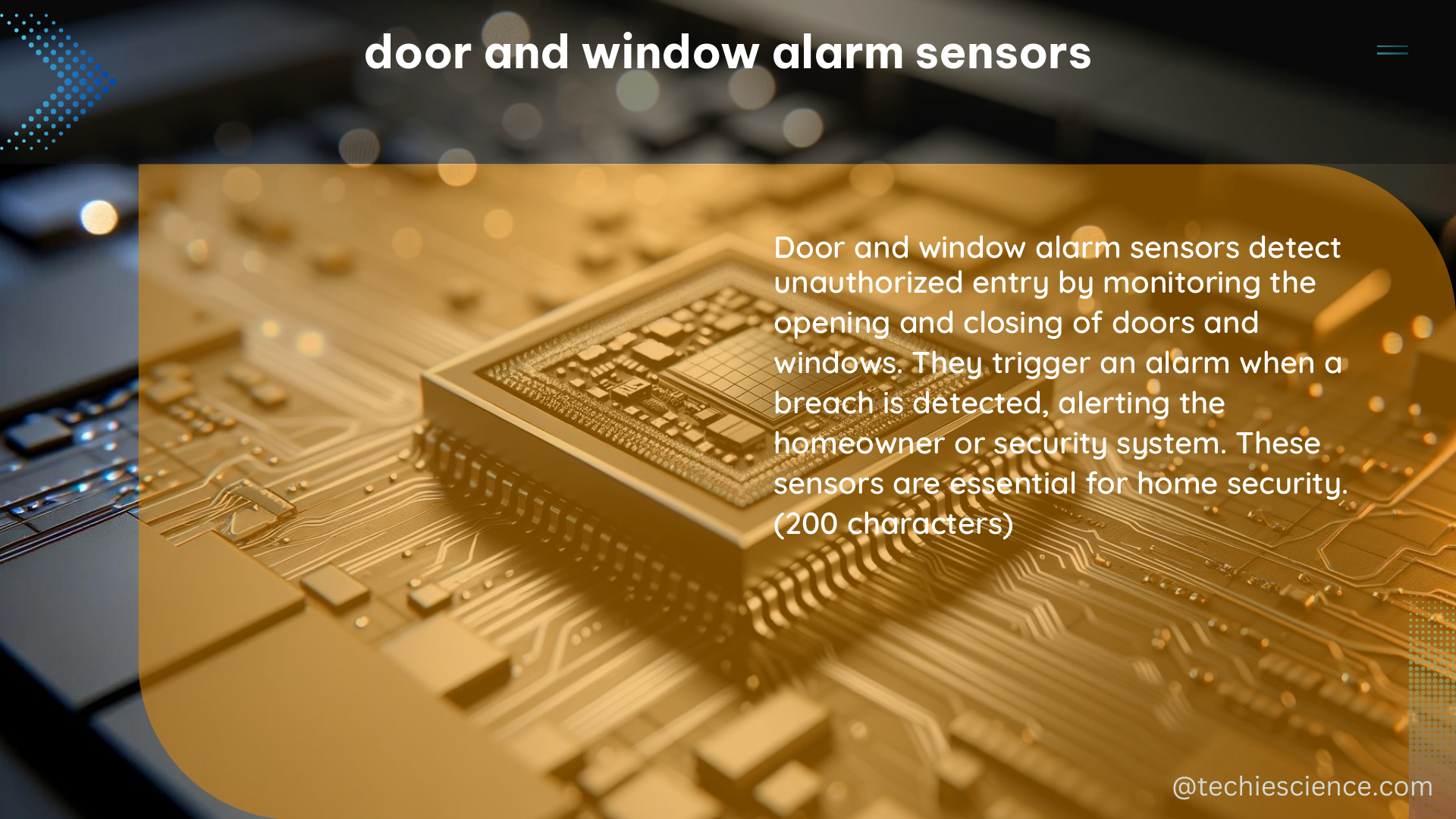Door and window alarm sensors are essential components of home security systems, providing real-time alerts when doors or windows are opened or tampered with. These sensors come in various types, sizes, and technical specifications, offering a range of features to suit different needs and preferences. In this comprehensive guide, we’ll dive deep into the world of door and window alarm sensors, exploring their key features, technical specifications, and installation considerations to help you make an informed decision for your home security needs.
Understanding the Basics of Door and Window Alarm Sensors
Door and window alarm sensors are designed to detect when a door or window is opened or closed, triggering an alert to the homeowner or security system. These sensors typically consist of two main components: a magnet and a reed switch. When the door or window is closed, the magnet and reed switch are aligned, creating a closed circuit. When the door or window is opened, the magnet and reed switch separate, breaking the circuit and triggering the alarm.
Types of Door and Window Alarm Sensors

-
Wired Sensors: Wired sensors are connected to the security system via physical wiring, providing a reliable and consistent connection. These sensors are often used in new construction or homes with easy access to run wires.
-
Wireless Sensors: Wireless sensors communicate with the security system using radio frequency (RF) or Bluetooth technology, eliminating the need for physical wiring. These sensors are more versatile and easier to install, making them a popular choice for retrofitting existing homes.
-
Dual-Technology Sensors: Dual-technology sensors combine multiple detection methods, such as magnetic and vibration sensing, to provide enhanced security and reduce the risk of false alarms.
-
Smart Sensors: Smart sensors integrate with home automation systems, allowing for remote monitoring and control via smartphone or voice commands.
Technical Specifications of Door and Window Alarm Sensors
-
Detection Range: The maximum distance at which the sensor can detect the opening or closing of a door or window. This is typically measured in inches or centimeters.
-
Operating Temperature: The range of temperatures within which the sensor can function properly, usually measured in degrees Fahrenheit or Celsius.
-
Humidity Range: The range of humidity levels the sensor can withstand without affecting its performance, typically expressed as a percentage.
-
Battery Life: The expected lifespan of the sensor’s battery, which can vary significantly depending on the sensor type and usage patterns.
-
Sensor Dimensions: The physical size of the sensor, which can impact its visibility and ease of installation.
-
Wireless Connectivity: The type of wireless protocol used by the sensor, such as Z-Wave, ZigBee, or Wi-Fi, which can affect compatibility with different home automation systems.
-
Tamper Detection: Some sensors feature built-in tamper detection, which can trigger an alarm if the sensor is removed or tampered with.
-
Mounting Options: The available mounting methods for the sensor, such as adhesive, screws, or magnetic mounts, which can affect the installation process.
Choosing the Right Door and Window Alarm Sensors
When selecting door and window alarm sensors, consider the following factors:
-
Home Layout and Needs: Assess the number and location of doors and windows in your home, as well as any specific security requirements you may have.
-
Compatibility with Existing Systems: If you have an existing home security system, ensure that the sensors you choose are compatible with the system’s protocols and components.
-
Installation Considerations: Evaluate the ease of installation, including the availability of mounting options and the need for wiring or power sources.
-
Smart Home Integration: If you’re interested in integrating your door and window sensors with a smart home system, look for sensors that offer seamless connectivity and remote access.
-
Reliability and Durability: Consider the sensor’s reputation for reliability, as well as its ability to withstand environmental factors like temperature and humidity.
-
Budget: Determine your budget and look for sensors that offer the best value in terms of features, performance, and cost.
Hands-On Installation and Troubleshooting
-
Sensor Placement: Carefully select the optimal locations for your door and window sensors, ensuring they are positioned to effectively detect openings and minimize the risk of false alarms.
-
Sensor Alignment: Properly align the magnet and reed switch components of the sensors to ensure reliable operation.
-
Wireless Connectivity: For wireless sensors, ensure a strong and consistent connection to your home’s Wi-Fi or Z-Wave/ZigBee network.
-
Battery Maintenance: Regularly check and replace the sensor batteries to maintain optimal performance and avoid unexpected failures.
-
Troubleshooting: Address any issues, such as false alarms or connectivity problems, by following the manufacturer’s troubleshooting guidelines and adjusting sensor placement or settings as needed.
Conclusion
Door and window alarm sensors are a crucial component of any comprehensive home security system. By understanding the various types, technical specifications, and installation considerations, you can make an informed decision and create a tailored security solution that meets your specific needs. This comprehensive guide has provided you with the knowledge and tools to become a DIY home security expert, empowering you to take control of your home’s protection.
References:
- Amcrest SmartHome Entry Sensor – Window and Door Protection: https://amcrest.com/smarthome-wireless-entry-sensor-al-consen1.html
- It’s 2023 and you have to buy door sensors, what’s your choice?: https://www.reddit.com/r/homeassistant/comments/11nq9yh/its_2023_and_you_have_to_buy_door_sensors_whats/
- Sensors for daily life: A review: https://www.sciencedirect.com/science/article/pii/S2666351121000425
- Door & Window Sensor – Frontpoint Security: https://www.frontpointsecurity.com/shop/door-window-sensor.html
- An Approach for Representing Sensor Data to Validate Alerts in Ambient Assisted Living: https://www.mdpi.com/1424-8220/12/5/6282

The lambdageeks.com Core SME Team is a group of experienced subject matter experts from diverse scientific and technical fields including Physics, Chemistry, Technology,Electronics & Electrical Engineering, Automotive, Mechanical Engineering. Our team collaborates to create high-quality, well-researched articles on a wide range of science and technology topics for the lambdageeks.com website.
All Our Senior SME are having more than 7 Years of experience in the respective fields . They are either Working Industry Professionals or assocaited With different Universities. Refer Our Authors Page to get to know About our Core SMEs.